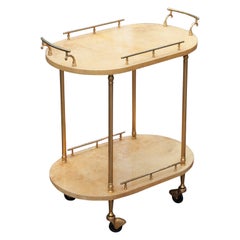Geraldo de Barros Barware
Although best known for his photography, Geraldo de Barros was an important contributor to the canon of mid-century modern furniture design and was one of Brazil’s most influential multidisciplinary artists.
Born in 1923 in Chavantes, São Paulo, de Barros began his artistic career as a painter before discovering a passion for photography in the 1940s. In 1950, he found fame with his successful “Fotoformas” exhibition held at the Museu de Arte de São Paulo, which led to a scholarship from the French government to study in that country.
In the early 1950s, de Barros traveled throughout Europe, including Switzerland, where he met Bauhaus graduate Max Bill. At the time, Bill was collaborating with the Scholl Foundation on developing a design institute in Ulm, Germany, that combined Bauhaus tradition with emerging technical elements in design practice. Bill invited de Barros to visit the institute, where he became influenced by Bill’s philosophy of Gute Form — the belief that carefully designed objects could bring artistic values into homes.
Upon his return to São Paulo, de Barros delved into furniture design. Along with engineer Justino Cardoso, metalworker Antônio Thereza, and a Dominican priest, Friar João Batista Pereira dos Santos, he founded the furniture company and Christian cooperative Unilabor, in 1954, on the outskirts of São Paulo.
As the firm’s chief designer, de Barros incorporated the concept of Concrete art into many of his pieces, particularly his armchairs. His dining room chairs, bookcases, coffee tables, cabinets and desks were also designed with straight lines, sobriety and functionality in mind and made with natural materials such as rosewood, jacaranda and iron. Given that it was more of a cooperative with a social mission than it was a manufacturer, Unilabor paid well and offered innovative modular furniture by way of de Barros-designed components that were produced serially to be used in the construction of complete furnishings.
Despite Unilabor’s success, the company ran into economic difficulties and eventually closed. Undaunted, de Barros founded another furniture company in 1964 — Hobjeto Indústria e Comércio de Móveis — where he focused on progressive furniture design with more geometric shapes.
During the 1960s, de Barros continued with furniture design and, as a painter, became interested in Pop art and abstract movements, founding influential groups such as Grupo 15, Galeria Rex and Grupo Ruptura.
In the 1990s, de Barros returned to his career as a photographer until his death in 1998. De Barros’s furniture was shown at several exhibitions during the 1950s and 1960s, including the Exposição Nacional de Arte Concreta in São Paulo in 1956 and the Konkrete Kunst exhibition in Zurich in 1960. His photographs and paintings have also been exhibited in museums and galleries worldwide.
On 1stDibs, discover a range of vintage Geraldo de Barros seating, tables, case pieces and storage cabinets.
1970s Brazilian Mid-Century Modern Vintage Geraldo de Barros Barware
Metal
2010s Mexican Art Deco Geraldo de Barros Barware
Brass
1960s Italian Hollywood Regency Vintage Geraldo de Barros Barware
Brass
1960s Italian Hollywood Regency Vintage Geraldo de Barros Barware
Brass, Iron
Mid-20th Century Italian Mid-Century Modern Geraldo de Barros Barware
Bamboo, Rattan
1970s American Mid-Century Modern Vintage Geraldo de Barros Barware
Chrome
Mid-20th Century Italian Mid-Century Modern Geraldo de Barros Barware
Brass
1960s Italian Hollywood Regency Vintage Geraldo de Barros Barware
Brass, Iron
Late 20th Century Mid-Century Modern Geraldo de Barros Barware
Teak
1960s American Mid-Century Modern Vintage Geraldo de Barros Barware
Wood, Cork
1950s Italian Mid-Century Modern Vintage Geraldo de Barros Barware
Bronze
1950s Italian Chinoiserie Vintage Geraldo de Barros Barware
Brass
1970s Italian Hollywood Regency Vintage Geraldo de Barros Barware
Brass, Stainless Steel


